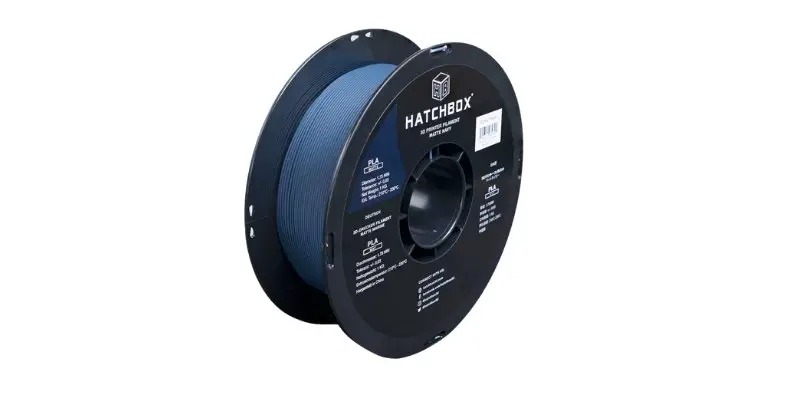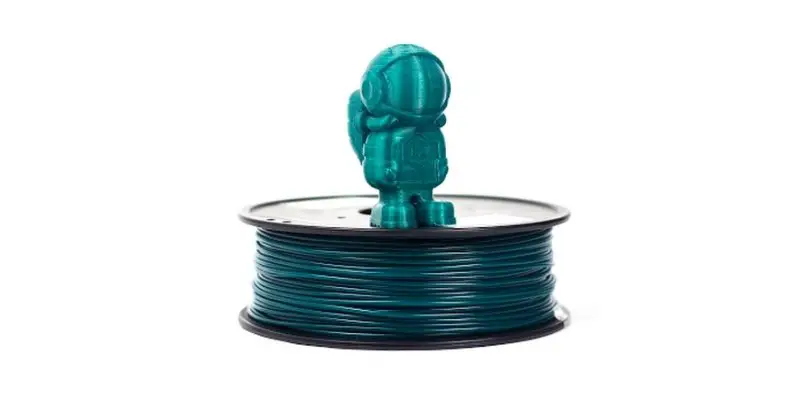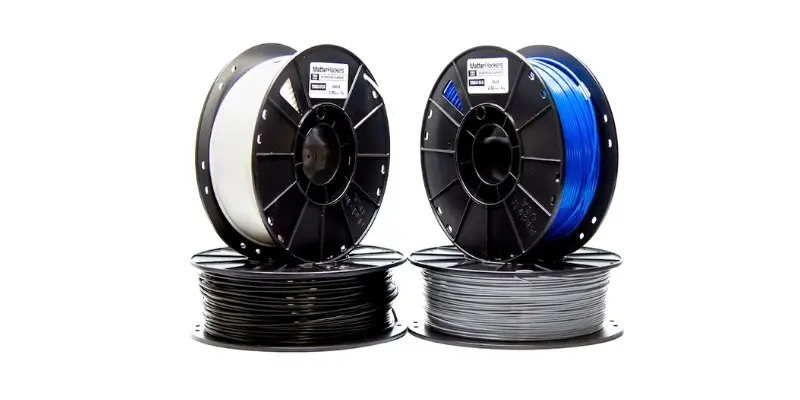PLA is by far the most popular FDM printing material. It prints easily on virtually all FDM printers, rarely causes failed prints, and is available in a huge range of colors and blends. To help you wade through this glut of options, we’ve pulled together this comprehensive guide to the best PLA around.
|
|
|
|
|
4.3
|
4.7
|
4.5
|
|
$24.99 ($0.71 / Ounce)
|
$20-25
|
$50-60
|
But with so many PLA brands competing for your cash, how to sort through the duds to find the best PLA filament? Buy cheap PLA filament, and you’re taking a gamble on quality. Conversely, no one wants to spend too much when there are lower-priced same-quality alternatives.
Different Types of PLA Filament
PLA – This is your standard PLA: affordable, readily available, and ideal for general-purpose 3D printing projects.
PLA Plus – PLA Plus (or PLA+, Pro PLA) aims to mitigate the downsides of straight PLA while retaining its easy-to-print appeal. This is achieved through different polymer formulas blending PLA with additives to make it stronger, resistant to higher temperatures, and with better flexible properties. An excellent choice if you need a material that’s more reliable than PLA but simpler to print than ABS or TPU.
Conductive PLA – This type of PLA is notable for its ability to conduct electricity well. Manufacturers mix PLA with particulates, usually carbon, to make conductive PLA suitable for electronic 3D printing projects.
Glow-In-The-Dark PLA – The clue is in the name here – Glow-In-The-Dark filament is formulated with phosphorescent additives. After exposure to a light source, the filament will make your prints glow. Perfect for hazard-signaling or Halloween-themed decorative projects.
Wood-Filled PLA – It features PLA alongside wood fiber, generally cedar, birch, pine, willow, ebony, olive, bamboo, and cherry. The advantages of wood-filled PLA are the aesthetics and feel of the finish, which is ideal for decorative pieces and projects that require a more rustic or natural look.
Metal-Filled PLA – Metal-filled blends PLA with powdered metal to make it slightly tougher. It also provides a shiny, metallic finish to prints. Metals commonly include bronze, stainless steel, copper, brass, and aluminum.
Magnetic PLA – Powdered iron is added to the PLA formula to make printed parts stick to magnets. Fridge magnets are a popular application.
Color-Changing PLA – Also known as thermochromic PLA, color-changing PLA filament reacts to temperature fluctuation, circling through two defined colors thanks to leuco dyes mixed in the PLA formula. The benefits are purely aesthetic, and the filament retains the same properties as PLA.
Scented PLA – A novelty PLA, if there ever was one, scented PLA produces a distinctive fragrance or smell, such as beer and coffee.
Silk PLA – A shinier, silkier version of standard PLA filament.
Best PLAs: Blends & Brands
1. MatterHackers Build Series PLA
- Price: $20-$25 — Available at Matterhackers here
- Nozzle Temperature: 205°C
- Heated Bed Temperature: 40°C-60°C
- Filament Diameter: 1.75 mm, 1.85 mm
- Colors: Black, pink, bronze, white, magenta, red, orange, yellow, lime green, forest green, green, blue, light blue, royal blue, purple, brown, tan, gray, natural, silver, gold, copper, teal
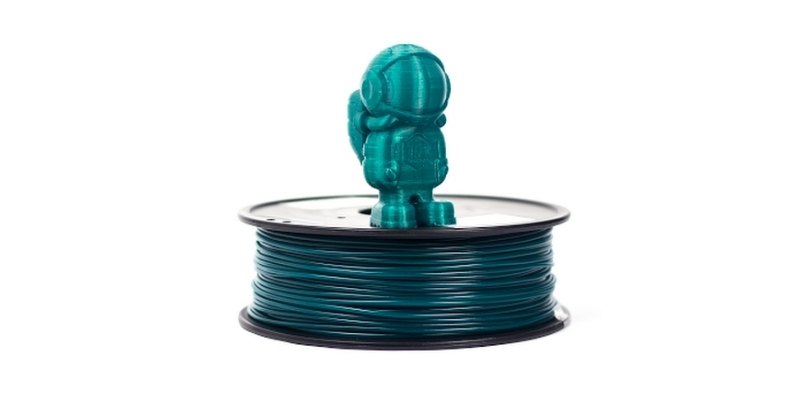
Pros
Affordable.
Resistant to snapping.
Decent 0.05mm dimensional accuracy.
Cons
Some small issues with stringing.
MatterHackers Build Series PLA is a low-cost affordable PLA filament intended for quality general-purpose 3D printing. This balance between affordability and solid quality printed parts make MatterHackers Build Series PLA a favorite among amateur makers. It’s known for being resistant to snapping, strong quality control, and a decent 0.05mm dimensional accuracy.
MatterHackers Build Series PLA offers one of the most extensive single-brand range of colors and finishes, including silky finishes and glow-in-the-dark, so you’re likely to find an option whatever the needs of your project.
2. MatterHackers PRO Series PLA
- Price: $50 — Available at Matterhackers here
- Nozzle Temperature: 205°C
- Heated Bed Temperature: 40°C-60°C
- Filament Diameter: 1.75 mm, 1.85 mm
- Colors: Black, white, silver, red, blue, parthenon gray, infinite void black, concrete gray, midnight blue, natural translucent, ectro green, burnt orange, jet gray, electric orange, terracotta red, lime green, regolith gray, lemon yellow, dark green, translucent aqua, emerald dream, dark translucent, tortoise green, teal blue, electric yellow, lilac pastel, antares red, royal blue, merlot red, translucent red, translucent ice blue, firefly green, succulent green, antique white, paper white, tangerine orange, burgundy, Caribbean blue, gold, chocolate brown, tan, pearl blue, grapefruit pink, translucent violet, clear red, solar flare
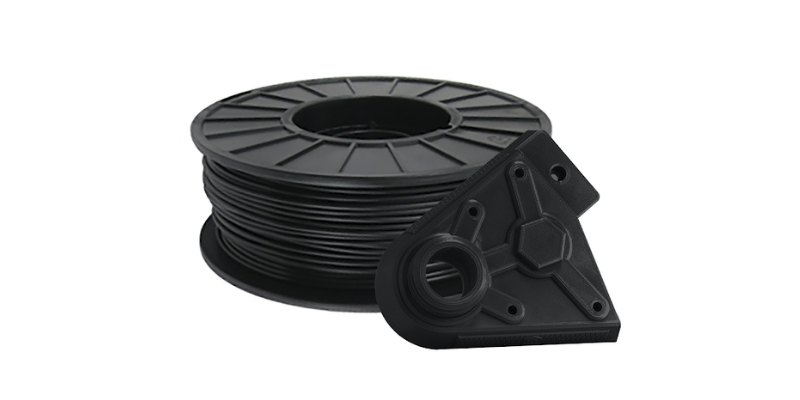
Pros
Produces high-quality printed parts for the price.
Excellent 0.02mm dimensional accuracy.
Reliable and consistent results.
Cons
Much like the build series, there is a bit of stringing issues.
MatterHackers PRO Series PLA is manufactured to produce superb, professional-grade, high-quality printed parts at a reasonable price. A precisely detailed chemical formula and excellent 0.02 mm dimensional accuracy ensure reliable and consistent results with every spool.
MatterHackers PRO Series PLA performs exceptionally well for functional parts, product-ready components, prototypes, and other demanding professional applications. Much like the Build Series range, MatterHackers PRO Series PLA is available in a dizzying selection of colors – you’re frankly spoilt for choice with every hue, finish, and tint you could ever need.
3. MatterHackers PRO Series Tough PLA
- Price: $50-60 — Available at Matterhackers here
- Nozzle Temperature: 220°C
- Heated Bed Temperature: 60°C
- Filament Diameter: 1.75 mm, 1.85 mm
- Colors: Black, gray, white, blue, light blue, green, jet gray, red, cotton candy pink, butterscotch gold, rust brown, purple, paper white, mint green, pistachio green, teal blue, yellow,
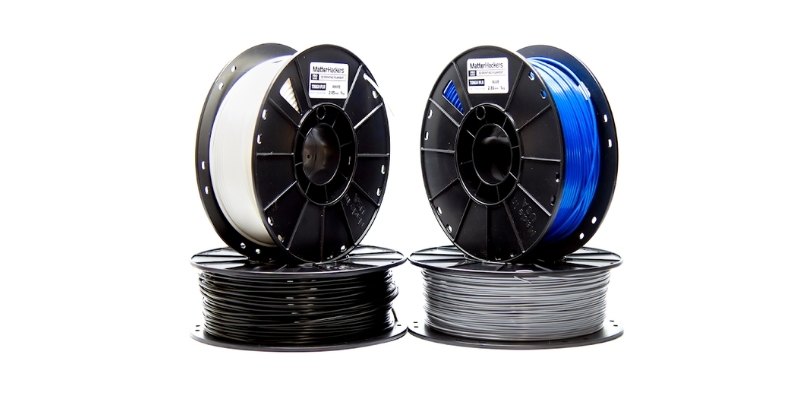
Pros
High-quality and reliable.
Added strength and durability from standard PRO PLA.
Strong impact and heat resistant.
Cons
Bit too expensive for just decoration work.
Marketed as an alternative to difficult-to-print ABS, MatterHackers PRO Series Tough PLA retains all the quality and reliability of the standard PRO PLA but adds strength and durability properties approaching those of ABS.
Strong impact and heat resistance make it a solid PLA-variant for functional prototyping and product-ready 3D printed parts. Better yet, it boasts superb layer adhesion, low warping, and looks just as great as MatterHackers straight PLA when it comes off the printer.
4. Hatchbox PLA
- Price: Check latest price at Amazon here
- Nozzle Temperature: 180°C-220°C
- Heated Bed Temperature: 0°C-60°C
- Filament Diameter: 1.75 mm, 1.85 mm
- Colors: Black, white, silver, red, blue, orange, gray, pink, light blue, mint, stone granite, pastel green, sparkle green, navy matte, bronze, purple, stone brick, stone brown, ash gray, beige
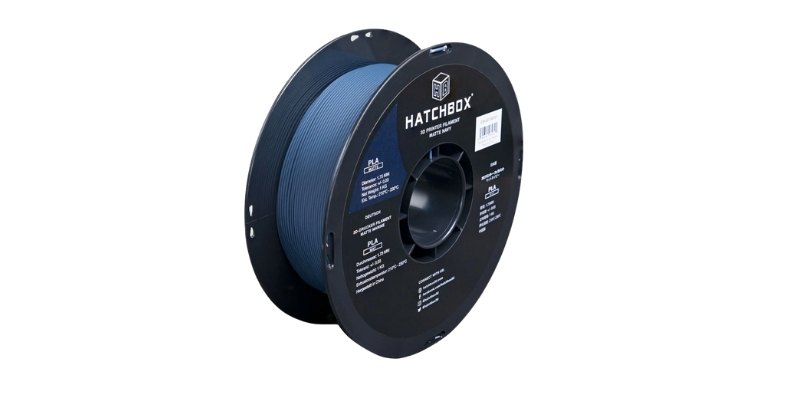
Pros
Superb accuracy for the price.
Good quality finishes with plenty of detail.
Reliable for daily use.
Cons
Some minor stringing issues.
Hatchbox PLA is a solid quality PLA that many thrifty makers swear by. It contains a blend of plant-based materials and polymers alongside a superb 0.03 mm dimensional accuracy for the price to make it one of the tougher varieties of standard PLA. Prints come out sharp with good quality finish, plenty of detail, and colors that pop. As a daily-use PLA that’s reliable, Hatchbox comes highly recommended.
HatchBox PLA rivals MatterHackers for the range of colors you can choose from, most also available in metallic, silk, matte, and transparent finishes. Hatchbox also sells a Glow in the Dark PLA for just a few dollars more if that tickles your fancy.
5. Prusament PLA
- Price: Check latest price at Prusa Store here / Amazon here
- Nozzle Temperature: 215°C
- Heated Bed Temperature: 50°C-60°C
- Filament Diameter: 1.75 mm
- Colors: Black, white, azure blue, silver, jet black, lipstick red, galaxy black, vanilla white, galaxy purple, gentleman’s gray, lime green, pink, gold, opal green, pearl mouse, pineapple, orange, royal blue, simple green, bronze, mystic brown, army green, mystic green, gravity gray
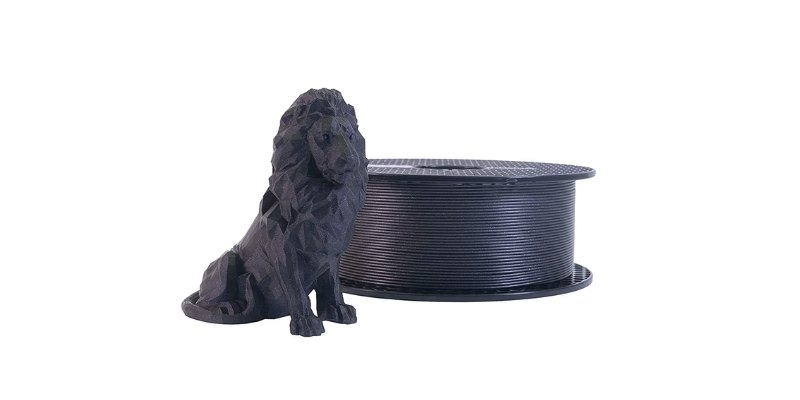
Pros
Easy to print.
Fantastic 0.02mm dimensional accuracy.
Scannable QR code to check the parameters and test results of each spool.
Cons
Can sometimes cause jams.
From the folks at Prusa of i3 MKS3+ fame, Prusament PLA is another value-packed low-cost filament that’s easy to print and therefore excels for everyday-use 3D printing projects.
It features a fantastic 0.02 mm dimensional accuracy (something you’d expect to pay much more for usually) and all the quality-controlled precision and consistency we’d expect from Prusa. The company’s confident enough in the quality of each spool to include a unique scannable QR code to check the parameters and test results of each spool.
You can find Prusament PLA is a pretty unique spread of vibrant colors, all quality controlled for consistent results with every print.
6. Amolen Color-Change and Glow-In-The-Dark PLA
- Price: Check latest price at Available here
- Nozzle Temperature: 190°C-220°C
- Heated Bed Temperature: 0°C-60°C
- Filament Diameter: 1.75 mm
- Colors: Green, teal, ocean green, deep blue, purple, pine/brown/yellow, white/hot pink, white/blue, white/purple, red/white, green/yellow
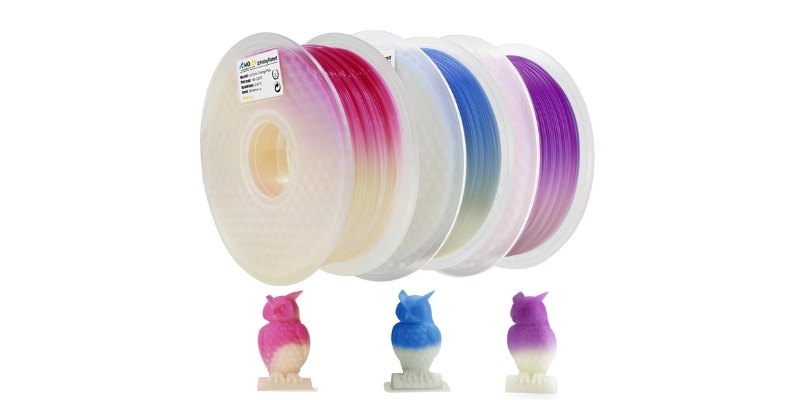
Pros
Solid accuracy and a smooth finish.
Glow-in-the-dark.
Good-quality and well-priced.
Cons
The extrusion of the material can be inconsistent.
Amolen offers well-priced, good-quality regular PLA, but we’re highlighting their color-changing PLA and Glow-In-The-Dark PLA for makers who want to jazz up their projects. These novelty PLAs generally come sided by a hefty premium, but Amolen keeps theirs within a reasonable price range. All come with a solid 0.03 mm dimensional accuracy and stand out for the quality, smooth finish.
They have a unique tri-color thermochromic filament that runs from pine to brown to yellow as the ambient temperature jumps from under 30°C to above 45°C. For those that want the best of both unique blends, there’s Amolen Glow-In-The-Dark Multicolor Change PLA – the spool changes color every 5 meters, cycling through green, blue, purple, and pink, while also being glow-in-the-dark throughout.
7. Sunlu PLA
- Price: Check latest price at Amazon here
- Nozzle Temperature: 190°C-230°C
- Heated Bed Temperature: 25°C-60°C
- Filament Diameter: 1.75 mm
- Colors: Black, white, red, blue, green, yellow, silver, gray, gold
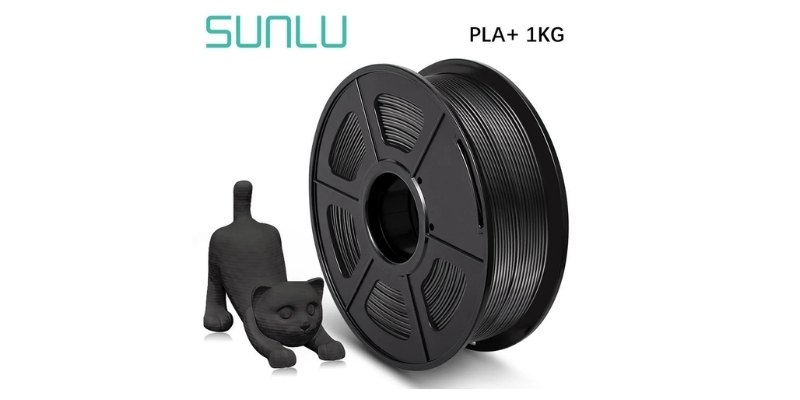
Pros
Clean details and reliable colors.
Very little in the way of adhesion and warping issues.
Sharp 0.02mm dimensional accuracy.
Cons
Can sometimes be hard to get it to stick.
Sunlu rightfully has a reputation for providing some of the best price-to-performance PLA on the market. Though it’s one of the cheapest out there, it’s a quality filament that prints great with a particular emphasis on clean details, reliable colors, and very little in the way of adhesion or warping issues.
Sunlu PLA also guarantees a sharp 0.02 mm dimensional accuracy for all its 100% tangle-free spools. It’s an excellent option for makers on a tight budget who need a no-nonsense, highly predictable PLA.
Beyond standard PLA, Sunlu also offers a good range of special blends, including tough PLA+, marble filament, smooth silk, and wood-filled PLAs. The color choice isn’t as expansive as some other brands, but Sunlu covers all the basic, maker-favorite hues.
8. Sunlu Recycled PLA
- Price: Check latest price at Amazon Here
- Nozzle Temperature: 195 °C
- Heated Bed Temperature: 60 °C
- Filament Diameter: 1.75mm
- Colors: Black, red, green, brown, yellow, pink
Sunlu recycled PLA provides an eco-friendly alternative to virgin PLA at a discounted price. It prints smoothly like normal PLA in my experience when using typical settings at 190-195C.
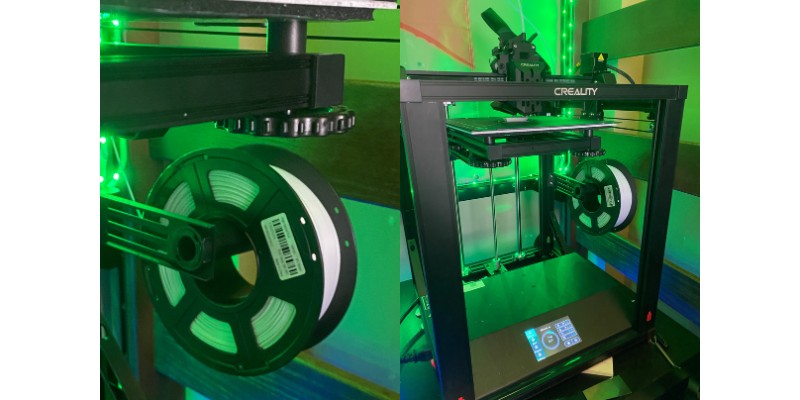
The tensile strength is very high for PLA, allowing for printed parts that can withstand more force without cracking or breaking.
This filament also comes in a wide variety of fun colors to choose from, which is rare for recycled filaments that often just offer black.
The only minor downsides I noticed are a dip in quality on overhangs and some minor moisture absorption when left out over time. But let’s be real, these are challenges most PLAs face.
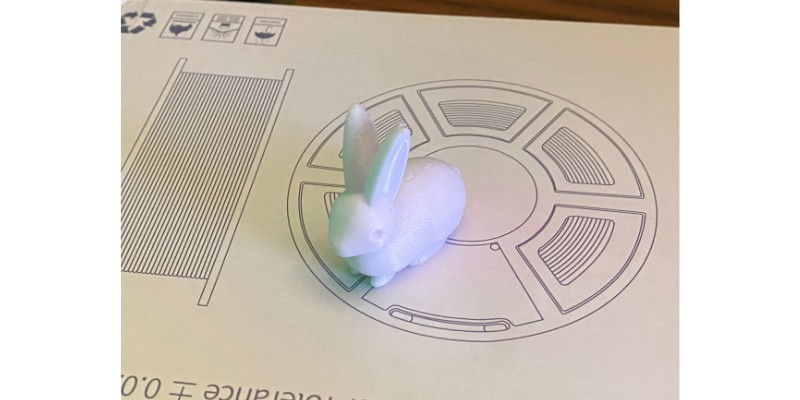
So, if you’re aiming for a reliable, eco-friendly PLA without compromising on quality, Sunlu recycled PLA is a solid contender. It’s a win for both your prints and the planet!
9. FormFutura PLA
- Price: Check latest price at Amazon here
- Nozzle Temperature: 200°C-230°C
- Heated Bed Temperature: 50°C-60°C
- Filament Diameter: 1.75 mm, 2.85mm
- Colors: Black, bronze, brown, dark blue, dark green, gold, gray, light blue, light green, light gray, yellow, magenta, natural, orange, red, sapphire gray, white, pink, lavender, mid blue
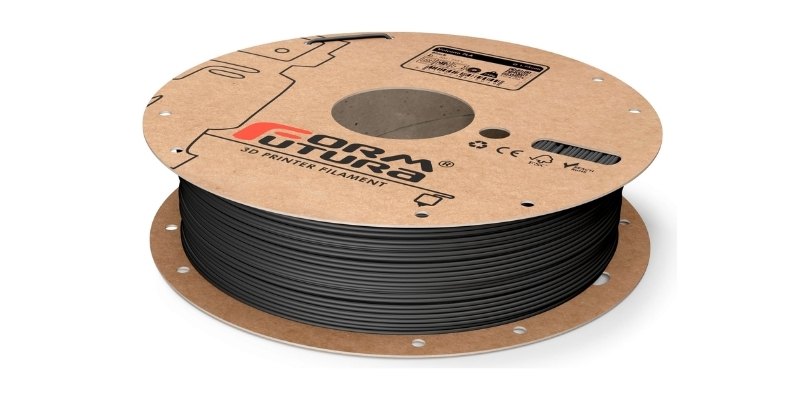
Pros
Range of PLAs at great prices.
High impact and high heat resistance.
Cons
Some problems relating to stringing.
Based out of The Netherlands, FormFutura sets itself apart from the more popular brands with a range of specialist PLAs at great prices. Its EasyFill PLA, as the name implies, banks on ease of use while also being tougher and less rigid than stock PLA. It’s also warp-free and shines for superb inter-layer adhesion and improved flow properties – a great general-use PLA.
Elsewhere, FormFutura offers a high-impact and high-heat-resistant variant known as Volcano PLA, a Premium PLA for more demanding applications, and ReForm rPLA formulated from recycled PLA waste. Then there’s a range of unique formulas such as cork-filled EasyCork, High Gloss PLA, Stone-Fill, antibacterial PLActive, MetalFil, and EasyWood.
10. Polymaker PLA
- Price: Check latest price at Amazon here
- Nozzle Temperature: 190°C-230°C
- Heated Bed Temperature: 25°C-60°C
- Filament Diameter: 1.75 mm, 2.85mm
- Colors: Black, white, gray, red, blue, green, yellow, orange, teal, purple, natural
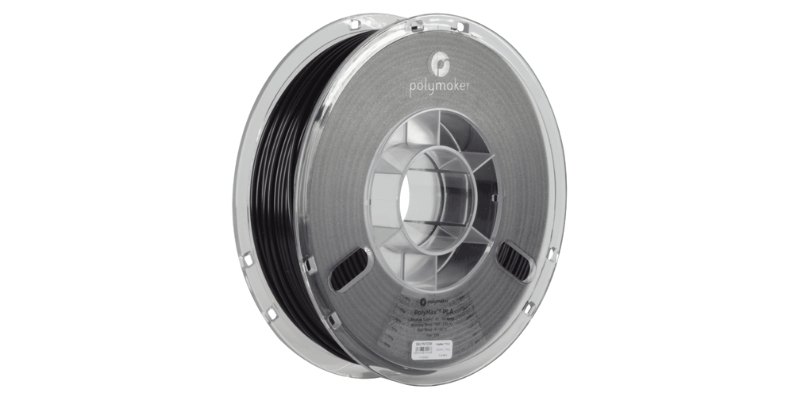
Pros
Smooth finish and is tough.
Well-priced for everyday use.
Cons
Some adhesion issues.
Polymaker is a big-name filament brand offering well-priced everyday use PLA made from the best raw materials suited to everything from home hobby projects to demanding professional prototyping.
PolyLite PLA is the company’s most popular, costing only a smidgen more than the more budget-oriented options out there. Siding Polylite, there’s PolyTerra, an eco-friendly variant where Polymaker plants a tree for every spool purchased. Both deliver a fantastic, smooth finish and are a tad tougher than straight PLA. For those looking for a more premium option, PolyMax PLA includes nano-reinforcement technology for improved mechanical properties and higher print quality than PolyLite PLA.
Unlike many PLA filament manufacturers, PolyMaker ships all its spools with resealable bags. PolyTerra goes a step further with recycled cardboard packaging and spool.
11. ColorFabb PLA
- Price: Check latest price at Amazon here
- Nozzle Temperature: 195°C-220°C
- Heated Bed Temperature: 50°C-60°C
- Filament Diameter: 1.75 mm, 2.85mm
- Colors: Over 200 colors and custom on-demand color service
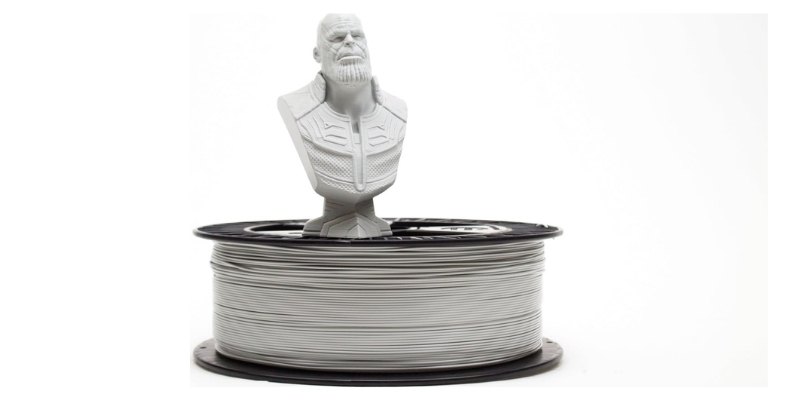
Pros
Best-in-class dimensional accuracy of 0.01mm.
Tougher than normal PLA.
Cons
Although worth the price, some may find it too expensive.
ColorFabb PLA is seriously good stuff. You’ll pay a little more than some other brands, but it’s well worth the extra cost. Not only does ColorFabb come in a variety of blends and price points, most of its PLA has a best-in-class dimensional accuracy of 0.01 mm and includes a special impact modifier additive to make it tougher than normal PLA.
Whether you opt for Economy PLA (big spools at a reasonable price), Light Weight PLA (for functional projects like RC planes and cars), or ColorFabb’s unique PLA/PHA (cuts down on the brittle properties of general PLA), expect excellent results and brilliant finish.
True to its name, ColorFabb is available in more than 200 colors. The company even offers a custom on-demand color service to help you land the perfect one for your projects, whether you need a single spool or a batch order.
12. Overture PLA
- Price: Check latest price at Amazon here
- Nozzle Temperature: 190°C-220°C
- Heated Bed Temperature: 25°C-60°C
- Filament Diameter: 1.75 mm
- Colors: Black, white, space gray, light gray, red, blue, purple, yellow, orange, pink, light blue, light green, jeans red, morning blue, brown, chocolate, sakura pink, wine, olive green, fresh red, light yellow, jeans blue, gray-blue, highlight yellow, royal cooper, cement gray, royal gold, green
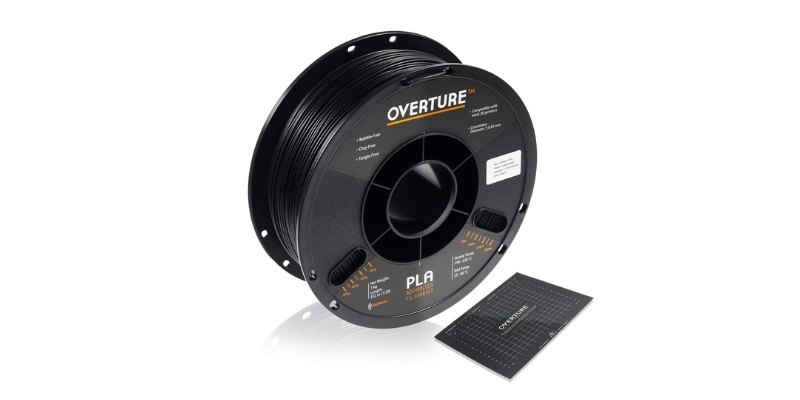
Pros
Clog-free and easy to use.
Reduced warping and good adhesion.
Cons
Some colors may not come out as well as others.
Overture joins the likes of Sunlu and Hatchbox as a brand aiming to offer quality PLA at an unmissable price. Overture’s PLA is clog-free, easy to use, and has a decent 0.05 mm dimensional accuracy. Overture’s so confident in their product’s reliability that they throw in a no-questions-asked lifetime guarantee.
Overture also sets itself apart in the budget portion by shipping every spool with a 200 x 200 mm removable magnetic build plate. It’s specially tuned to work wonders for first-layer adhesion and reduce warping when paired with Overture’s PLA. To cap it off, Overture includes a vacuum resealable nylon bag with desiccants to keep the PLA nice and try when it isn’t fuelling your day-to-day projects.
Overture also proposes Easy PLA, Eco PLA, Matte PLA, Professional PLA, Silk PLA, and a special Rock PLA – all self-explanatory and excellent if you’re looking for something different from straight PLA.
13. Ultimaker PLA
- Price: $70.00 — Available Check latest price at Matterhackers here
- Nozzle Temperature: 200°C-210°C
- Heated Bed Temperature: 60°C
- Filament Diameter: 2.85 mm
- Colors: Magenta, orange, black, blue, silver, transparent, white, red, green, yellow, pearl
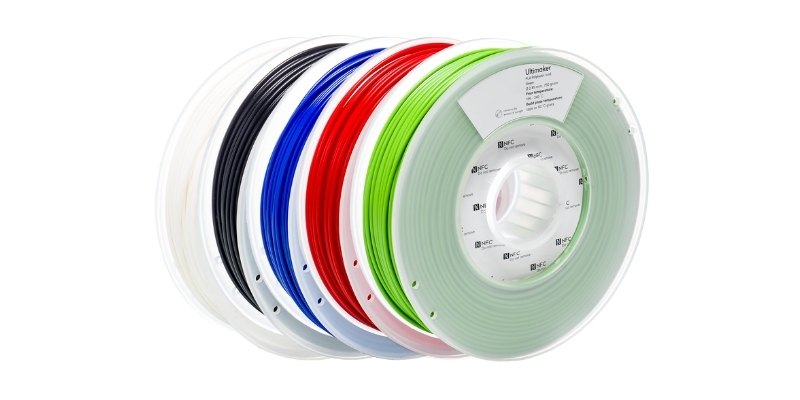
Pros
Superb finish.
A range of vibrant colors.
Cons
Very expensive compared to others on this list.
Ultimaker PLA is a premium, high-quality PLA that boasts a superb surface finish and is available in a range of vibrant colors. Typical applications include high-detail modeling, proof of concept designs, and casts for metal/ceramic parts.
It’s chiefly geared towards Ultimaker printers (and even has NFC-chip technology that allows the printer to find the optimal printer settings for the color and material) but pairs equally well with any 3D printer than 2.85 mm diameter filament.
Ultimaker also offers a Tough PLA that approaches the toughness of ABS while retaining the ease of printing of PLA. Ultimaker recommends it for functional prototypes and tooling at larger sizes.
Recommended PLA Settings
PLA is lenient when it comes to printer settings, performing well with various settings. However, here are some baseline setting ranges to get you going on the right foot.
- Nozzle Temperature: 190°C to 230°C
- Heated Bed Temperature: 50°C to 70°C
- Print Speed: 20 mm/s to 100 mm/s
Advantages and Disadvantages
Advantages of PLA
- Inexpensive: PLA is one of the cheapest FDM printer filaments, starting at around $20 for a 1 kg spool. PLA is available in a huge range of colors and different blends to suit all manner of applications.
- Biodegradable: As PLA is made from organic sources, it is environmentally friendly and decomposes naturally.
- Odorless: PLA doesn’t produce any odors when melted.
- Easy to print: PLA is flexible when it comes to settings, and it’s possible to obtain excellent quality prints with most consumer FDM 3D printers.
Disadvantages
- Brittle: If you’re worried about how strong is PLA, it has very low impact resistance and shatters easily.
- Not durable: PLA cannot withstand sustained friction or wear and tear.
- Low temperature resistance: PLA melts are relatively low temperatures, with softening occuring at temperatures as low as 50°C and melts at around 130°C.
- Not suitable for outdoor use: Though PLA’s biodegradability is an advantage, it also means the filament doesn’t fare well at all when left out in the elements.
Applications and Uses
- Models, figurines, miniatures and other decorative toys/pieces
- Cos-play costumes, props
- Household items like vases, self-watering plant pots, cases and storage solutions, toothpaste squeezers, pen holders, lamps, clocks, stands, bottle openers, coasters, drain covers, phone holders
- 3D printer parts: filament clips, fan ducts, brackets, leveling knobs, cabling strain relief, mounts
- Low-cost prototypes, and concept models
- Jewelry, necklaces, earrings, rings
- Architectural models
Buyer’s Guide – What 3D Printer Do You Need To Print PLA
Unlike filaments like ABS and exotic materials that need specific features to thrive (enclosure, all-metal hot end, etc.) PLA printing is possible with all FDM 3D printers. Therefore, the question of what 3D printer you need to print PLA morphs into what are the best FDM 3D printers and, more importantly, your budget.
Low-cost 3D printers like the Ender 3 range and Ender 3 S1, Voxelab Aquila S2, and Anycubic Kobra, or pricier printers like the Prusa i3 MK3S+ are also excellent options for printing PLA.
What Is the Best Way to Store PLA Filament?
Though PLA isn’t as hygroscopic as other filaments like nylon and TPU, it’s good practice to keep it stored in an airtight container or sealed bag with desiccant sacs to avoid moisture degradation, especially if you leave it unused for long periods.
If your printer is placed in a low humidity environment and you’re printing from the same spool daily, leaving it on the spool holder is fine for a few days at a time.
How to Dry PLA Filament?
The easiest way to dry PLA is to place it in a domestic oven at around 45°C-50°C degree for four hours. Doing so removes any stored moisture.
Alternatively, you can invest in a purpose-designed filament dryer.
More reliable and hands-off than DIY oven drying, filament dryers take care of the entire drying process, leaving you with a bone dry spool within just a few hours. Many are also designed with an opening to feed filament through so that you can keep the PLA protected even while printing.
Where to Buy PLA Filament?
You can buy PLA filament directly from manufacturers. Big online retailers like Amazon also stock an ever-growing selection of PLA filament from the best 3D printer filament brands.
Other popular outlets include MatterHackers, who don’t just sell their own PLA but also those of most other major brands.
You may also find PLA available at brick and mortar hardware outlets such as Home Depot or smaller independent DIY hobbyist stores.
How Many Meters of Filament in 1KG PLA?
The length of a 1 kg spool of PLA depends on the density of the filament. For standard 1.24g/cm3 density PLA, a 1 kg spool includes roughly 330 to 340 meters of filament.
For exact figures, try our filament length calculator. We also have another guide on how long a spool of PLA will last if you print constantly.
PLA Filament FAQs
What Is the Best Brand of PLA Filament?
Personal preference plays a significant role in determining the best brand of PLA filament, so pinpointing a specific name includes a good dose of personal bias. That said, brands like MatterHackers, Prusament, Colorfabb, Ultimaker, and Polymaker are all contenders for the best PLA brand title and are known for offering some of the best quality PLA filament.
What Color PLA Filament Shows Detail Best?
Neutral colors such as white and gray tend to show off print detail better than loud, vibrant colors. An added benefit of these subdued colors is that they are well suited to painting, which can greatly enhance subtle details as the paint seeps into grooves, corners, and creases.
What Glue Works Best With PLA Filament?
If your project involves printing smaller parts, then joining them together to complete a larger model, you’ll invariably require some form of adhesive. In PLA’s case, look for glues that work well with rigid plastics. Standard Super Glue works well, as do competing brands like Gorilla Glue. Epoxies and acetone welding are also other popular options for bonding PLA parts.
Why Does My PLA Filament Keep Breaking?
PLA that keeps breaking or is extremely brittle before printing is commonly a sign of a low-quality, cheap PLA filament, where the manufacturer hasn’t included enough strengthening additives and compounds, or the quality control isn’t up to scratch.
Another potential culprit is moisture. As PLA absorbs moisture, it tends to lose much of its malleability. Wet PLA will shatter even under low stress. Another common issue leading to snapped PLA is the botched winding on the spool, where the PLA effectively gets trapped as it tries to unwind with no other option than to break as the printer pulls it through the filament path.
What Is PLA Made Of?
PLA is made from fermented plant-based, organic starch from sugar cane, maize, corn, tapioca, cassava, and sugar beet pulp.
As these are renewable and the manufacturing process is far less resource-demanding than petroleum-based plastics, PLA is considered environmentally friendly. It’s also naturally biodegradable.
Other related articles:
- Every 3D printer filament type
- PLA filament guide
- Best ABS filament
- Best TPU filament
- Best Nylon filament
- Best Nylon 3D printers
- Best ABS 3D printers
- PLA, ABS, and PETG shrinkage: Everything you need to know
- How long does 1KG filament last? (Calculated)
- Which filaments are best for Ender 3?
- Is PLA safe for aquariums? (And other filaments)

